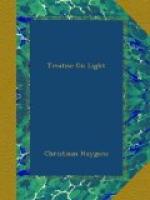Now it is apparent here that the angle of reflexion is made equal to the angle of incidence. For the triangles ACB, BNA being rectangular and having the side ab common, and the side CB equal to Na, it follows that the angles opposite to these sides will be equal, and therefore also the angles CBA, Nab. But as CB, perpendicular to CA, marks the direction of the incident ray, so an, perpendicular to the wave BN, marks the direction of the reflected ray; hence these rays are equally inclined to the plane ab.
But in considering the preceding demonstration, one might aver that it is indeed true that BN is the common tangent of the circular waves in the plane of this figure, but that these waves, being in truth spherical, have still an infinitude of similar tangents, namely all the straight lines which are drawn from the point B in the surface generated by the straight line BN about the axis Ba. It remains, therefore, to demonstrate that there is no difficulty herein: and by the same argument one will see why the incident ray and the reflected ray are always in one and the same plane perpendicular to the reflecting plane. I say then that the wave AC, being regarded only as a line, produces no light. For a visible ray of light, however narrow it may be, has always some width, and consequently it is necessary, in representing the wave whose progression constitutes the ray, to put instead of a line AC some plane figure such as the circle HC in the following figure, by supposing, as we have done, the luminous point to be infinitely distant. Now it is easy to see, following the preceding demonstration, that each small piece of this wave HC having arrived at the plane ab, and there generating each one its particular wave, these will all have, when C arrives at B, a common plane which will touch them, namely a circle BN similar to CH; and this will be intersected at its middle and at right angles by the same plane which likewise intersects the circle CH and the ellipse ab.
[Illustration]
One sees also that the said spheres of the partial waves cannot have any common tangent plane other than the circle BN; so that it will be this plane where there will be more reflected movement than anywhere else, and which will therefore carry on the light in continuance from the wave CH.




